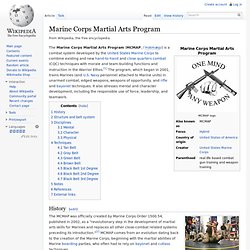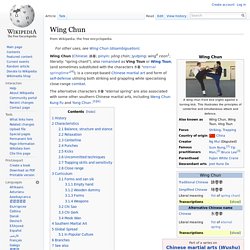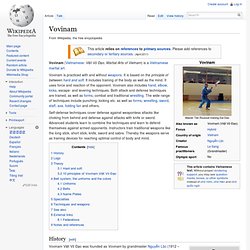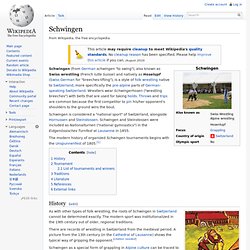

Dambe. Dambe, also known as Kokawa is a form of boxing associated with the Hausa people of West Africa.

Historically, Dambe included a wrestling component, known as Kokawa, but today it is essentially a striking art. The tradition is dominated by Hausa butcher caste groups, and over the last century evolved from clans of butchers traveling to farm villages at harvest time, integrating a fighting challenge by the outsiders into local harvest festival entertainment. It was also traditionally practised as a way for men to get ready for war, and many of the techniques and terminology allude to warfare. List of martial arts weapons. List of martial arts weapons From Wikipedia, the free encyclopedia Jump to: navigation, search.

Special Combat Aggressive Reactionary System. Special Combat Aggressive Reactionary Systems (SCARS) is an American combat fighting system created by Jerry L.

Peterson.[1] Founding[edit] SCARS is based on sciences of psychology, physiology, physical movement as well as research on the nervous system. SCARS was developed by Peterson after serving two tours in the US Army 173rd Airborne Brigade during the Vietnam War.[2] It was debuted in 1987,[3] and began to be taught to various military, law enforcement, and security units, such as the Arizona State police.[2] Currently, SCARS is taught through private seminars, larger scale contracts, online training and DVDs. It contains no defensive actions, as all checks against the enemy's kicks or punches are delivered as strikes to vulnerable nerves. The program is based upon the idea that every human body reacts in the same way to specific injuries, and the program puts together various strikes to specific nerves, bones, and organs in order to debilitate an aggressive individual. Marine Corps Martial Arts Program. The Marine Corps Martial Arts Program (MCMAP, /ˈmɪkmæp/) is a combat system developed by the United States Marine Corps to combine existing and new hand-to-hand and close quarters combat (CQC) techniques with morale and team-building functions and instruction in the Warrior Ethos.[1] The program, which began in 2001, trains Marines (and U.S.

Navy personnel attached to Marine units) in unarmed combat, edged weapons, weapons of opportunity, and rifle and bayonet techniques. It also stresses mental and character development, including the responsible use of force, leadership, and teamwork. History[edit] During World War I these bayonet techniques were supplemented with unarmed combat techniques, which often proved useful in trench warfare. Between the world wars, Colonel Anthony J. In July 2011, MCMAP performers from San Diego demonstrated for the Koyamada Foundation's United States Martial Arts Festival at the Redondo Beach Performing Arts Center in Redondo Beach, California.[3][4] Wing Chun. Wing Chun (Chinese: 詠春; pinyin: yǒng chūn; Jyutping: wing6 ceon1; literally: "spring chant"), also romanised as Ving Tsun or Wing Tsun, (and sometimes substituted with the characters 永春 "eternal springtime"[4]); is a concept-based Chinese martial art and form of self-defense utilising both striking and grappling while specialising close-range combat.

The alternative characters 永春 "eternal spring" are also associated with some other southern Chinese martial arts, including Weng Chun Kung Fu and Yong Chun .[5][6] History[edit] The earliest known mentions of Wing Chun date to the period of Red Boat Opera. The common legend as told by Yip Man[7] involves the young woman Yim Wing-chun, (Wing Chun literally means 'forever springtime' or 'praising spring'), during the period after the destruction by the Qing government of the Southern Shaolin and its associated temples. Bando. Pehlwani. Pehlwani (Hindi: पहलवानी, Urdu/Shahmukhi: پہلوانی, Punjabi: ਪਹਿਲਵਾਨੀ, Bengali: পালোয়ানি) or kusti (Hindi: कुश्ती,Marathi: कुस्ती, Urdu/Shahmukhi: کشتی, Punjabi: ਕੁਸ਼ਤੀ, Bengali: কুস্তি) is a form of wrestling from South Asia.

It was developed in the Mughal era by combining native malla-yuddha with influences from Persian koshti pahlavani.[1][2] The words pehlwani and kusti derive from the Persian terms pahlavani and koshti respectively. A practitioner of this sport is referred to as a pehlwan while teachers are known either as guru or ustad, depending on their religion.[2] Many southern Indian practitioners of traditional malla-yuddha consider their art to be the more "pure" form of Indian wrestling, but most South Asians do not make this clear distinction and simply view kusti as the direct descendent of ancient malla-yuddha, usually downplaying the foreign influence as inconsequential.
Vovinam. Vovinam (Vietnamese: Việt Võ Đạo, Martial Arts of Vietnam) is a Vietnamese martial art.

Self-defense techniques cover defense against weaponless attacks like choking from behind and defense against attacks with knife or sword. Advanced students learn to combine the techniques and learn to defend themselves against armed opponents. Savate. Savate (French pronunciation: [savat]), also known as boxe française, French boxing, French kickboxing or French footfighting, is a traditional French martial art which uses the hands and feet as weapons combining elements of western boxing with graceful kicking techniques.[3][4][5][6] Only foot kicks are allowed unlike some systems such as muay Thai, and silat which allow the use of the knees or shins.

Savate is a French word for "old shoe". Savate is perhaps the only style of kickboxing in which the fighters habitually wear shoes. Schwingen. Schwingen is considered a "national sport" of Switzerland, alongside Hornussen and Steinstossen.

Schwingen and Steinstossen were included as Nationalturnen ("national gymnastics") in the Eidgenössisches Turnfest at Lausanne in 1855. Canne de combat. Canne de combat is a French martial art.

As weapon, it uses a cane or canne (a kind of walking-stick) designed for fighting. Canne de combat was standardized in the 1970s for sporting competition by Maurice Sarry. The canne is very light, made of chestnut wood and slightly tapered. A padded suit and a fencing mask are worn for protection. List of martial arts. There are a large number of distinct styles and schools of martial arts. Sometimes, schools or styles are introduced by individual teachers or masters, or as a brand name by a specific gym. Martial arts can be grouped by type or focus, or alternatively by regional origin. This article focuses on the latter grouping. For hybrid martial arts, as they originated from the late 19th century and especially after 1950, it may be impossible to identify unique or predominant regional origins. It is not trivial to distinguish "traditional" from "modern" martial arts.
A large portion of traditional martial arts can be categorized as folk wrestling (see the separate article), although in some cases a folk wrestling style and a modern combat sport may overlap or become indistinguishable from each other once the sport has been regulated. Africa[edit] Ringen. Ringen is the German language term for grappling (wrestling).
In the context of the German school of historical European martial arts during the Late Middle Ages and the German Renaissance, ringen refers to unarmed combat in general, including grappling techniques used as part of swordsmanship. The German tradition has records of a number of master-Ringer of the 15th to 16th centuries specializing in unarmed combat, such as Ott Jud. Unarmed combat was divided in two categories, sportive grappling or geselliges ringen and serious unarmed combat or kampfringen (where kampf is the Early Modern German term for "duel"). The German tradition of ringen was eclipsed during the 17th century as the modern Baroque understanding of nobility precluded the participation of the higher classes in wrestling matches.
Wrestling continued to be practiced among the lower classes, giving rise to the various traditional styles of folk wrestling. History[edit] Sambo (martial art) The pioneers of Sambo were Viktor Spiridonov and Vasili Oshchepkov. Oshchepkov died in prison as a result of the political purges of 1937 after accusations of being a Japanese spy.[3] Oshchepkov spent much of his life living in Japan and training judo under its founder Kano Jigoro. The two men independently developed two different styles, which eventually cross-pollinated and became what is known as Sambo.
Compared to Oshchepkov's judo-based system, then called "Freestyle Wrestling", Spiridonov's style was softer and less strength dependent. This was in large part due to Spiridonov's injuries sustained during World War I.[4] Anatoly Kharlampiev, a student of Vasili Oshchepkov, is often considered the founder of Sport Sambo. Army hand-to-hand fight.
Zen Do Kai. History[edit] The first Zen Do Kai dojo was opened at Elizabeth Street, Melbourne. Jones states that it was originally intended to cater for those who worked in the security industry.[1] Zen Do Kai follows the classical martial arts model with a distinct hierarchy, a philosophy and the promotion of the ethical code of Bushido. Krav Maga. Krav Maga /krɑːv məˈɡɑː/ (Hebrew: קְרַב מַגָּע [ˈkʁav maˈɡa], lit. Eskrima.